There was a lot of suspicion and paranoia kicking around during the time of the USSR and in order to ensure that artistic-types, especially writers, filmmakers etc., toed the party line, the committee members of the Communist Party of the Soviet Union (CPSU) did away with existing creative organisations and, instead, replaced them with a series of unions that all professionals in that particular field had to be a member of.
The ideology behind the establishment of these unions was very simple – all artistic expression was to be in the style of socialist realism, the officially sanctioned art form of the USSR.
I’m not going to go into too much detail about socialist realism and what it represents. You can read more in the above Wiki link but, in brief, the genre uses the application of art to venerate socialist values. From its inception in the early 1930s (when Stalin was in charge) up until the late 1980s and the eventual collapse of the Soviet Union, countless examples of rousing utopian art in various styles and forms were created throughout the USSR as well as beyond, in countries that also followed the socialist model.
Depicting the proletariat, political figures, soldiers, national heroes (who were approved by the state) as well as important historical events, the physical art mostly took the form of paintings, sculptures, mosaics and murals. It was nearly always sanctioned by the CPSU and other artistic expressions, namely literature, theatre, film and music, also fell into this category.
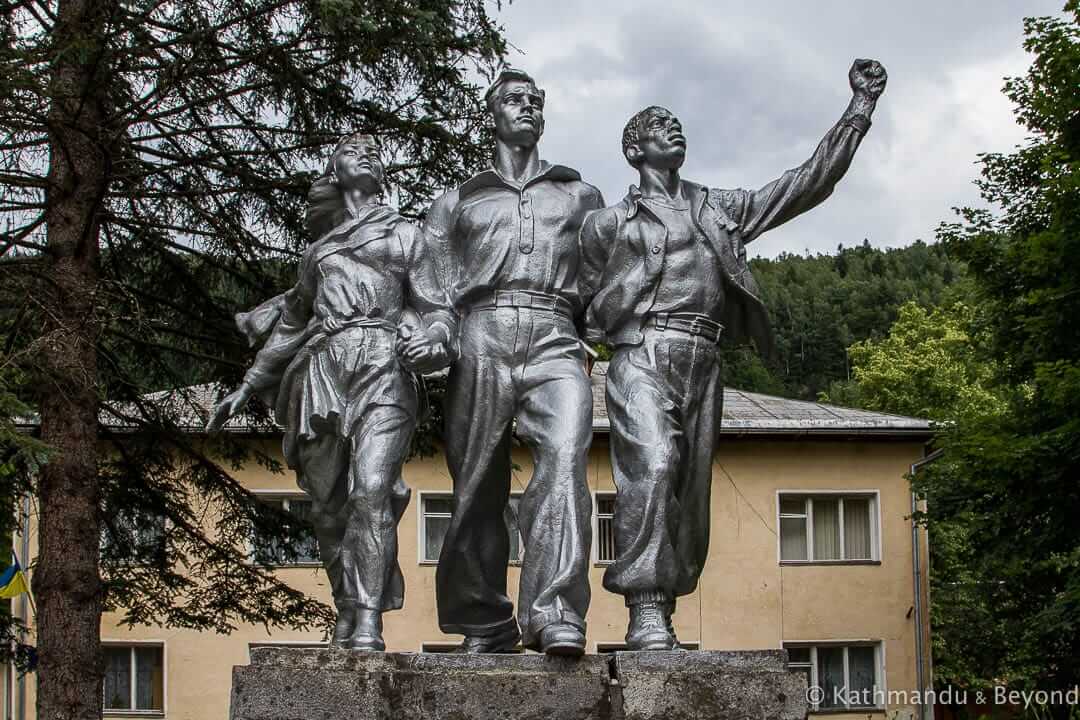
A typical example of socialist realism. Photo taken in Yaremche in Ukraine

Although initially, the establishment of the artistic unions was so that the CPSU could keep tight control over what was being created art-wise, there were also benefits for members. Like other unions, the Composers’ Union of the USSR was founded in the 1930s and, one of the privileges afforded to both seasoned and fledgeling professional composers and musicologists was the opportunity to spend time at one of the organisation’s vacation houses. More like a resort than a single house, these places were also established by other associations such as the Artists’ Union of the USSR and the Union of Soviet Writers as examples. They were almost always in secluded, peaceful spots (spread across the USSR) and were not only designed to give members a congenial and inspiring location in which work but also to serve as a reward, providing a place for rest and relaxation.
These retreats were far from perfect – there was pressure to produce hardcore ideological compositions for example (*), but they would have still been pleasant places to spend a week or so and the now-abandoned Composers’ house in Borjomi, south-central Georgia, would have been no exception.
(*) What follows is a short example of the effect socialist realism had on artists at the time. The Russian composer, Dmitri Shostakovich (1906-1975) wrote many symphonies (fifteen in all) and twice, in 1936 and then again in 1948, had his work denounced by Stalin’s mouthpiece, Pravda. He was forced to withdraw his 4th symphony, which is now considered to be one of his best compositions, and lived in fear of Stalin’s judgement of his works, expressed through the state-controlled critics of Pravda. Shostakovich’s works were heavily influenced by Igor Stravinsky (1882-1971). Although also born in Russia, Stravinsky lived most of his life in other countries. He left in 1914, three years before the revolution, and only returned to the motherland in 1962, when he was invited to do so by Nikita Khrushchev. During his exile, his work was also denounced by Stalin, in 1949. Upon his return he not only conducted some of his music, he also met with Shostakovich but, apparently, the meeting went badly because Shostakovich was nervous and Stravinsky was cruelly critical of many of his compositions.
Our visit to the Composers’ House in Borjomi
The small spa town of Borjomi is located in a valley and surrounded by dense forest on all sides. It’s renowned for its slightly fizzy, very salty, and totally disgusting (in my opinion) mineral water and has attracted visitors since the early part of the 19th century. The climate is pleasant and the air is clean – in fact, the location is perfect for those seeking creative inspiration but it wasn’t until the early 1980s that the region came to the attention of the Composers’ Union and the House for Composers (as I’ve also seen it named) was subsequently constructed in the hills on the outskirts of the town.
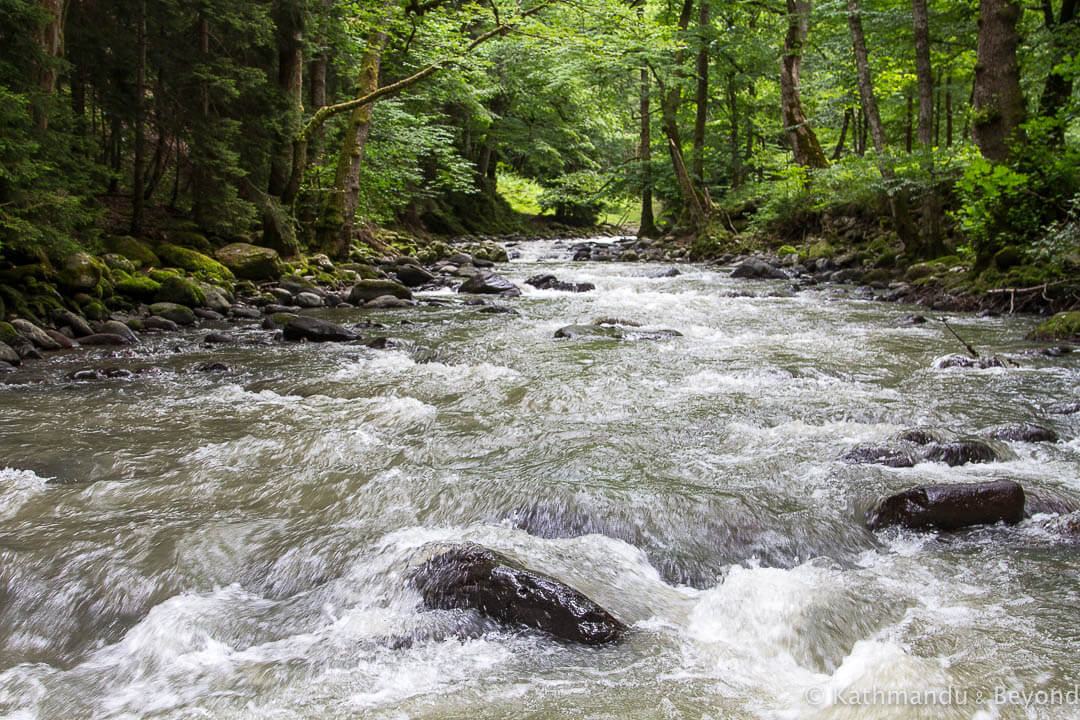
Scenic forest like this surrounds the spa town of Borjomi
It’s no exaggeration when I say that it took us a couple of days to locate this place and, when we eventually did, it was only because of a fortuitous cancellation of the excursion we had planned for that day.
We knew of the existence of the Composers’ House in Borjomi before we arrived in the town because we had seen photos of the retreat’s main, modernist-style building on the Internet. But, that was about it – we had no idea if there was more to it than just this one building or whether it was still in use or not.
What’s more, we had no clue as it its whereabouts and so headed to the Tourist Information Centre in Borjomi to see if they could help us. The guy on duty said he hadn’t visited the place in years but thought it was still OK to do so. He also said it was no longer in use but had no idea what state it was in. He pinned the location on our Google Map for us and also showed us where it was on a paper version. This was a good start but, unfortunately, he was wrong on both accounts, as we discovered when we headed off the following day to try and find it.
After spending far too long walking around looking for the building without success – our search included a wild goose chase in the woods above the town, a couple of shots of chacha (Georgian brandy) with two friendly (and drunk) woodcutters and a run-in with a rainstorm that we only escaped when a minivan load of Russian tourists stopped and gave us a lift back into town – we decided to chalk this one up as a failure. Besides, we only had one more day left in Borjomi before leaving for our next destination and had planned to spend it travelling on the Borjomi–Bakuriani (“little cuckoo”) narrow-gauge railway.
It really bugs Kirsty when she has to give up on things (me not so much!) and while we were waiting for the train the next morning, I noticed she kept staring intensely at a map on her phone and then looking up at the deeply-forested hills behind the station. While pointing at the forest, she came to the conclusion that the Composers’ House was definitely up there somewhere. I commended her on her perseverance but pointed out that the train ride would take up most of our day. I then went off to buy some snacks for the journey and when I returned, I was greeted with the news that the train had been cancelled due to a landslide on the tracks.
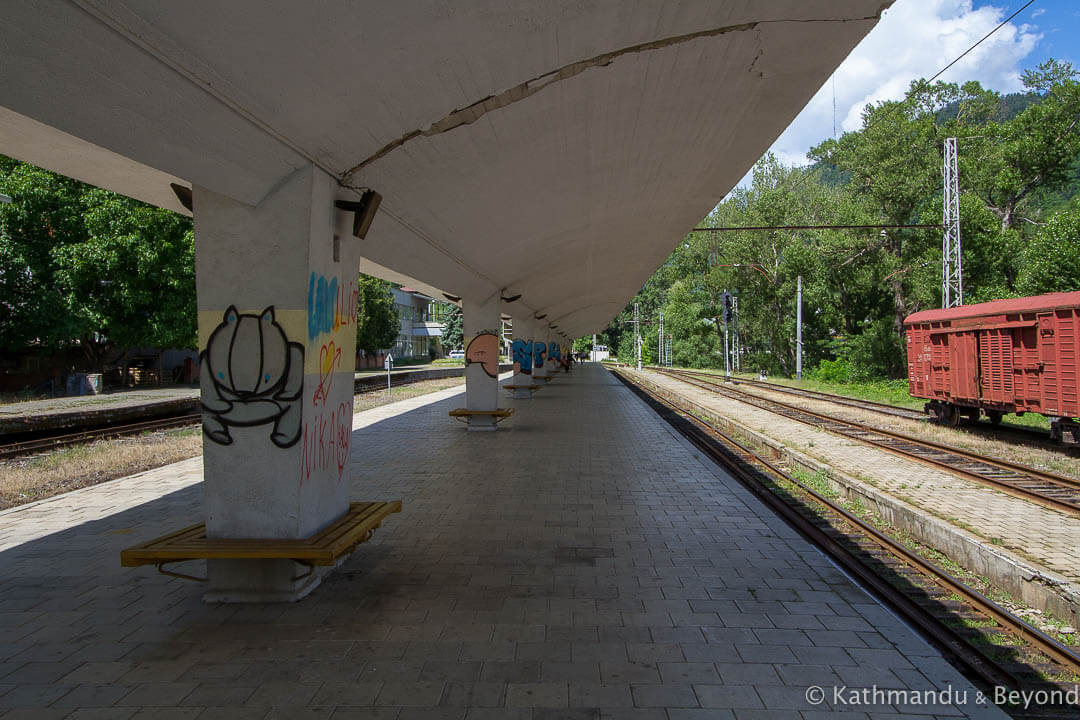
No sign of the train that was to carry us on the Borjomi–Bakuriani (“little cuckoo”) narrow-gauge railway
I wasn’t as convinced as Kirsty was about the location of the retreat, but she’s been right before with her hunches and detective work and as we now had some time on our hands, we decided to give it a shot. We found the small (and very steep) path and began to follow it. The path ended abruptly after about ten minutes of walking and, from then on in, we had no option but to push our way through the undergrowth or give up (again!), and go back the way we had come.
We chose the former but had no idea if we were near the building or not, as we lost the phone signal in the thick of the woods and were just relying on intuition. We heard voices and stopped dead in our tracks. After listening intently for a few seconds, we decided they were non-threatening and continued through the bushes. Then we hit a stroke of good fortune – the voices we’d heard were a mother and her daughter out in the forest picking mushrooms and berries. We further lucked out, when the daughter spoke to us in more than passable English and said she could direct us to our intended destination. It transpired that Kirsty’s inkling had been correct and we suddenly found ourselves on the backside of the complex.
We thanked our guides for their assistance and then headed off to take a look around. The outlying buildings had clearly seen better days. Nearly all of them were gutted and some had even collapsed in on themselves but the dominating modernist-style structure that had drawn us up the mountain in the first place appeared to still be in pretty good shape.
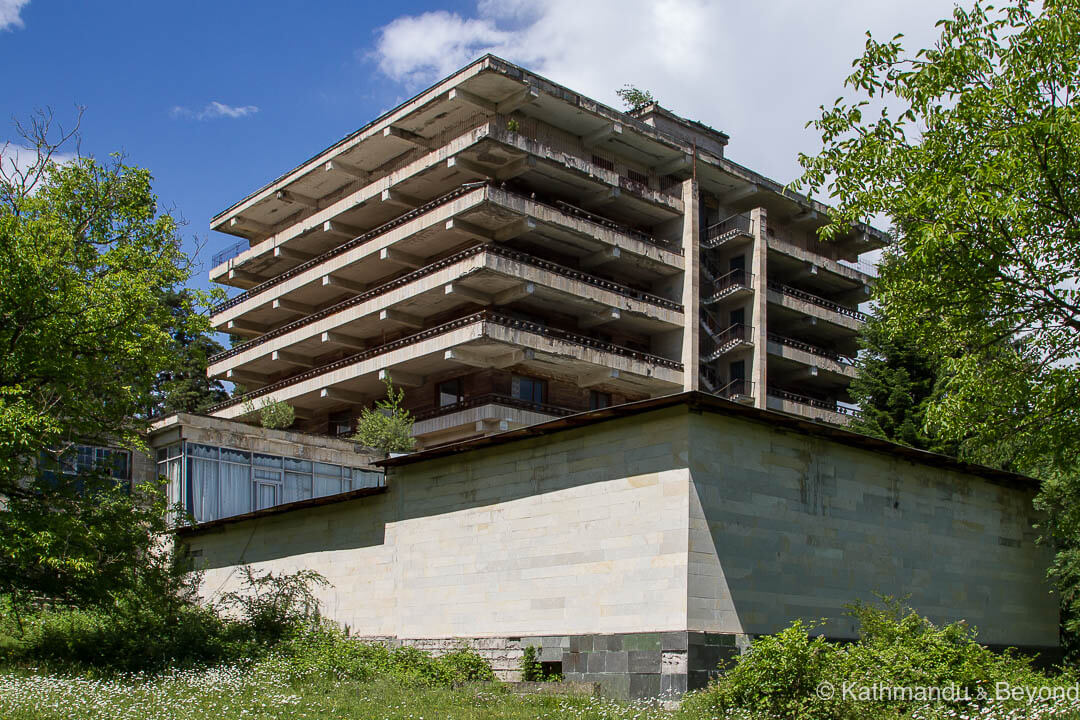
The main structure of the Composers’ house
It didn’t look as if there was anyone on the premises so we decided to take a look around the grounds before seeing if we could get inside the main building. The area was surprisingly large and it took us quite a while to explore it fully and by the time we got back to where we had started, there was a beaten-up Lada parked around the side of the main entrance and we could hear the sound of a couple of Georgian men shouting loudly at the top of their voices from one of the high-up floors. Among other things, I wondering why they hadn’t left their car closer to the entrance when, all of a sudden, a huge plank of wood, quickly followed by several more, came hurtling down from several floors above, landing exactly where I presumed they would have parked the car.
Luckily, we were a good distance from the projectile planks but it quickly became apparent that we would probably have to forego the prospect of a peek at the building’s interior. We did hide out for a while to see if they would head off and we even contemplated letting them know we were there and asking if we could go inside but, in the end, we gave up on that idea. The main doors, presumably because of the workers, were wide open but all the other possible entry points were sealed and there was no other way in.
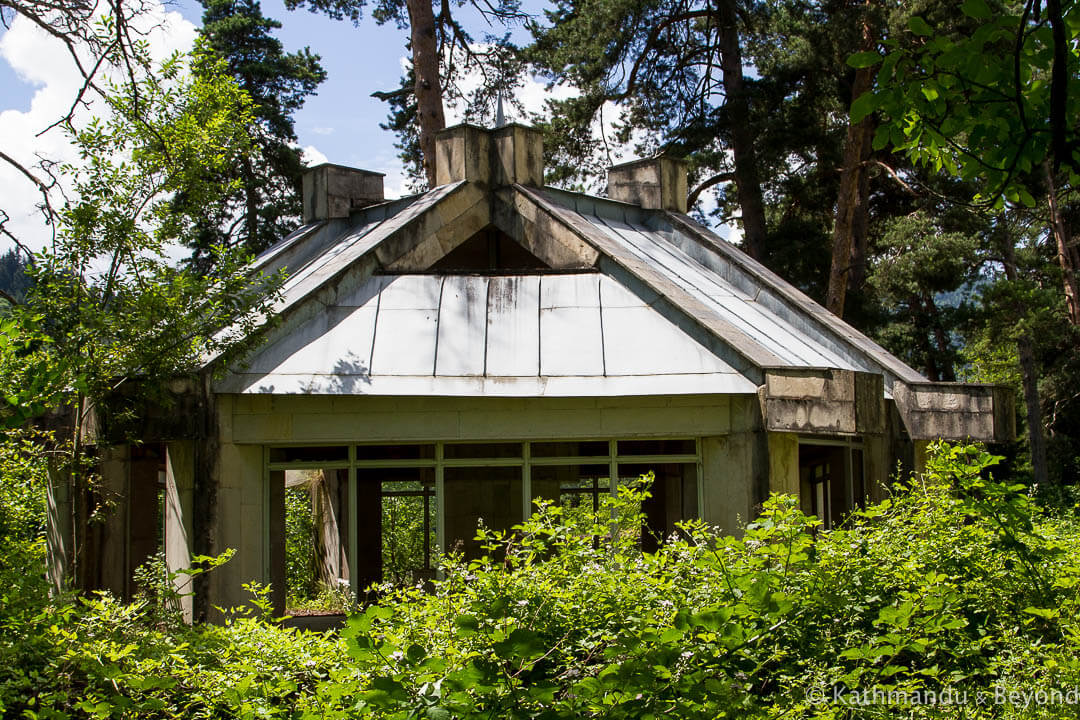
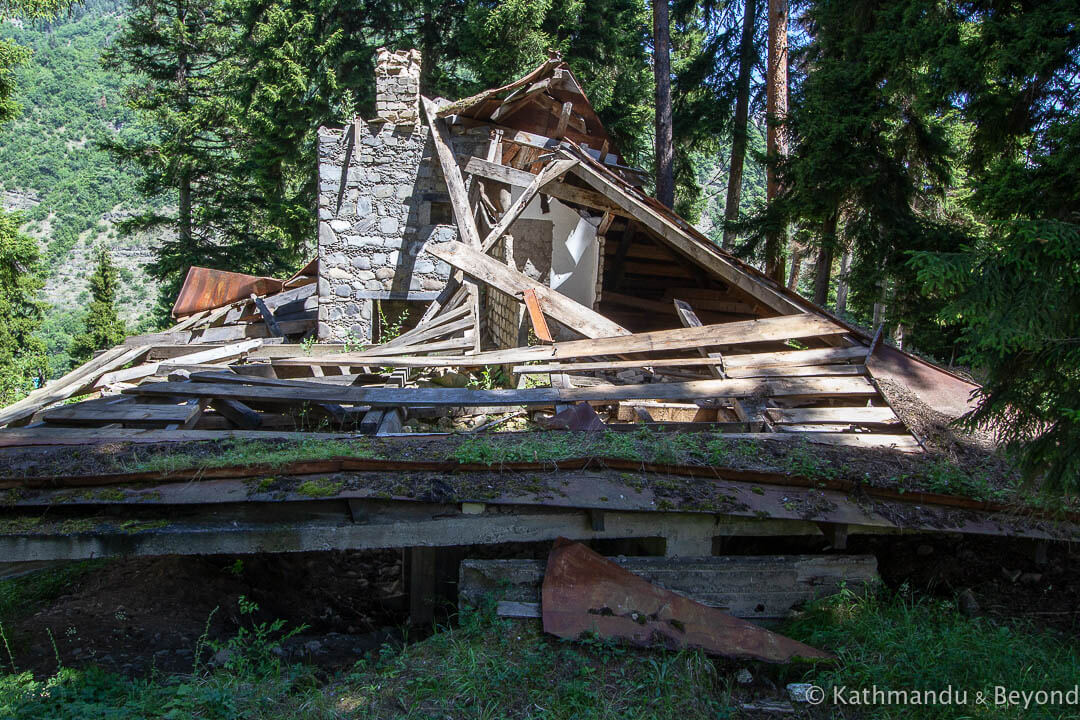
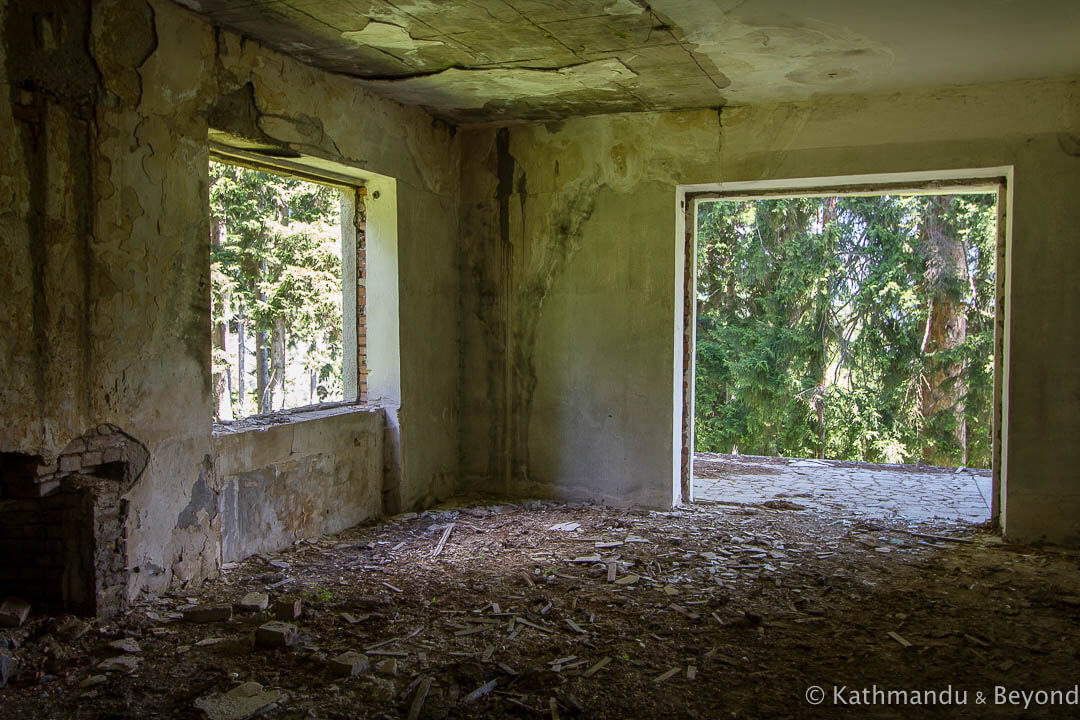
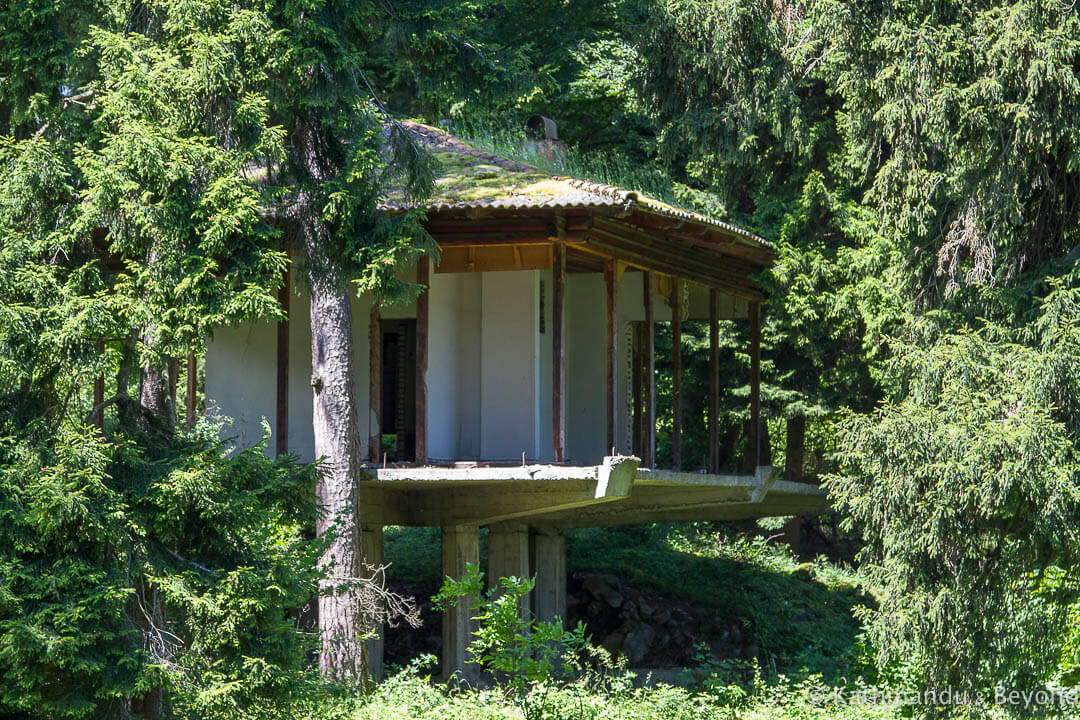
Only slightly disappointed that we didn’t get to explore the inside of the main building (we were still riding high on the fact that we’d found the place in the first instance), we decided to call it a day. We didn’t fancy going back the way we had come and so followed the main path that we assumed the workers had used to enter the grounds. After a short while, we spotted a large padlocked gate, a rather ferocious (but thankfully chained up) dog, and a guard’s hut that was manned. We only had a few seconds to come up with a plan once the dog had noticed us and started barking. We could either jump off the path back into the woods and look for another way out or keep going and greet the guard with an “I’m a lost tourist” grin and ask for directions to the nearby cable car station.
We decided on plan B and, although he was a rather perplexed to see us when he came out of his hut to find out what was causing the commotion, he did return our greeting, shut the dog up, dutifully opened the gate and told us which direction to head in for the cable car. Before he had a chance to think it through any further, we were long gone!
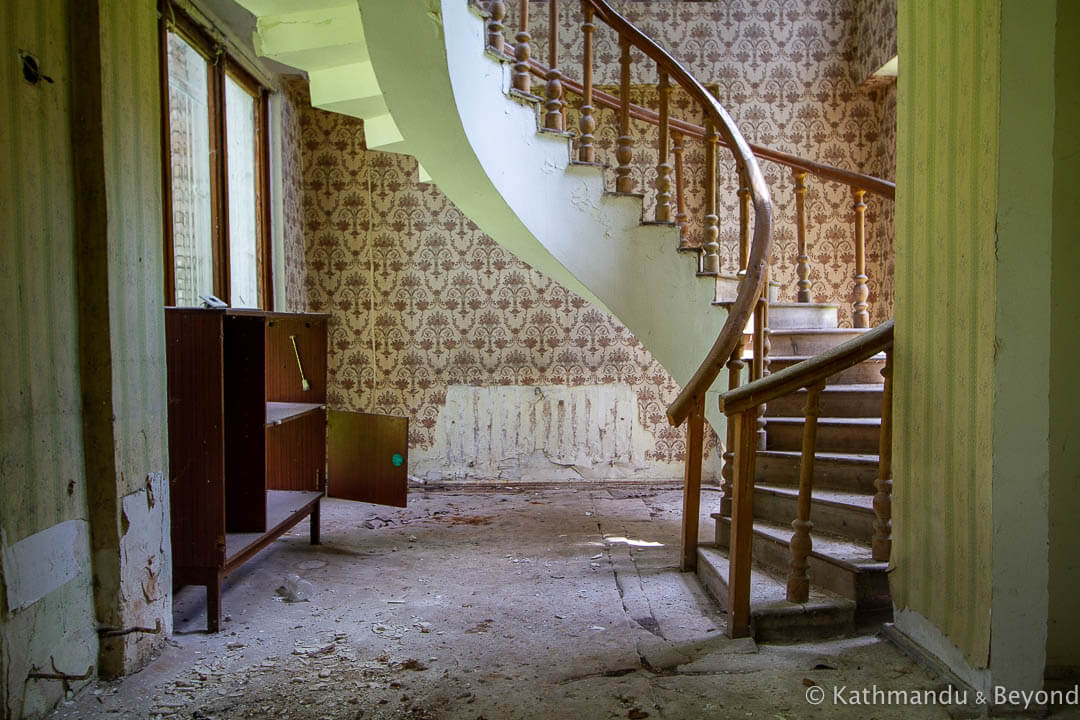
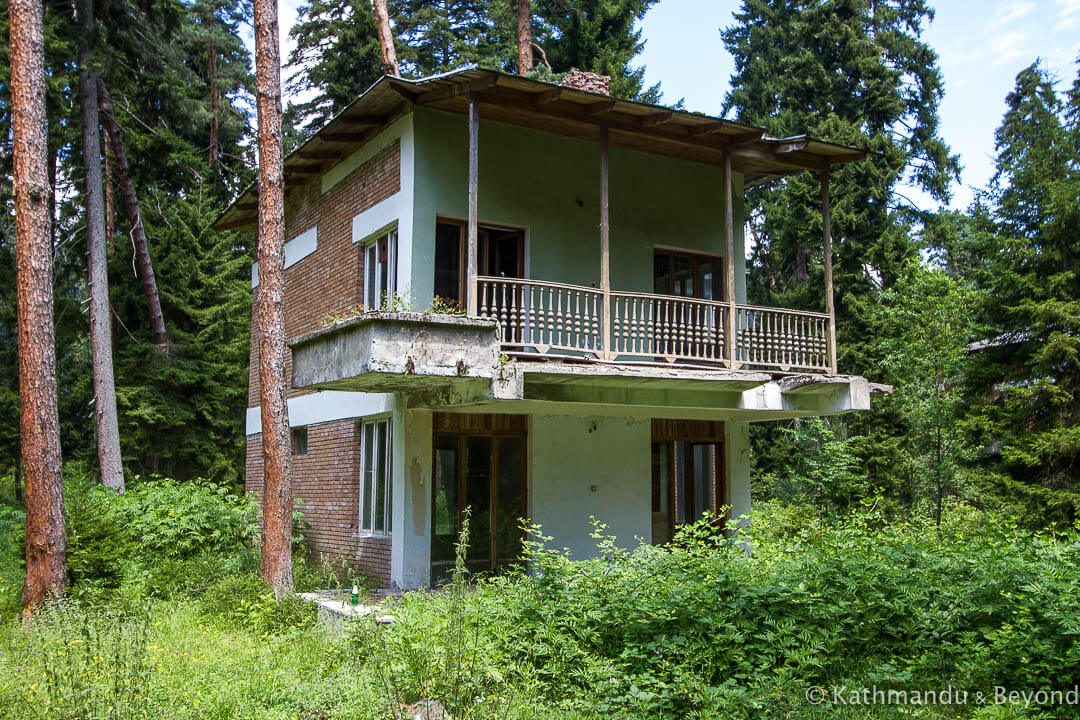
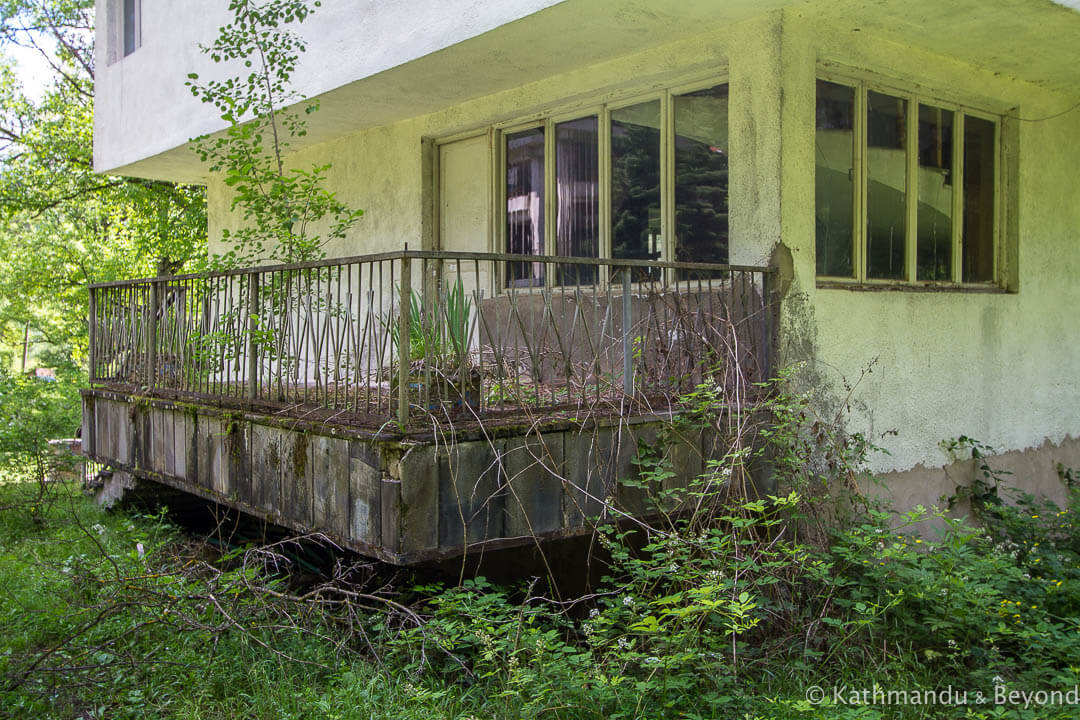
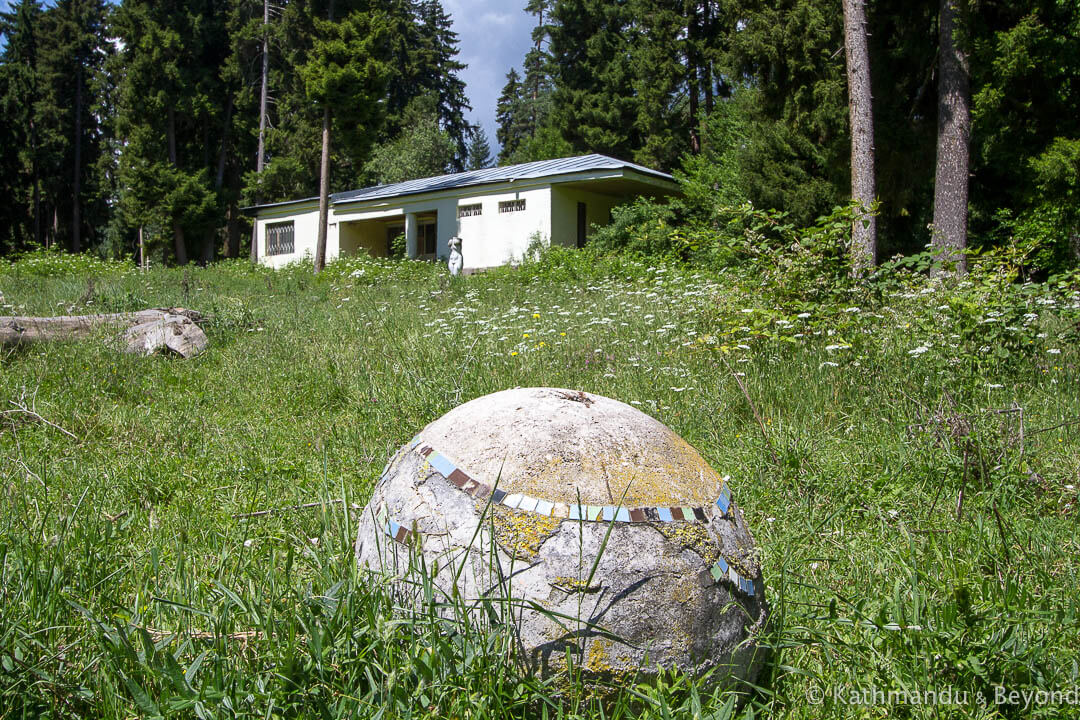
What happened to the Composers’ House in Borjomi?
I had a hard time finding much information about the Composers’ House in Borjomi. I have seen photos of the place online dated 2006 and it looks like it was still in use at that point. I’ve also found an online Human Rights Georgia article dated January 2007 that details a dispute over ownership of the land/buildings between the Composers’ Union and the Georgian government (Ministry of Economics), with the legal outcome resulting in the latter’s favour.
My assumption, therefore, is that the Composers’ Union were told they could no longer use the place at some point not long after the above ruling and were instructed to vacate the premises. Then I reckon that the Ministry of Economics didn’t know what to do with buildings and the land thereafter or had trouble selling it on and privatising it, and that’s why the place has ended up neglected and fallen into a state of disrepair.
Given that during our visit in the summer of 2018 we saw evidence of work being carried out as well as security measures in place, it’s reasonable to conclude that that’s all about to change or, indeed, has already done so given at least five months have passed since we were there.
As with so many resort towns of its time, Borjomi’s popularity waned after the dissolution of the Soviet Union in the early 1990s, but it’s on the rise again and I suspect that, in the not-so-distant future, there will be a very nice spa resort on the grounds of the former Composers’ House in Borjomi.
The Composers’ House was a great location for a spot of urban exploration and it felt like we had been the first people to visit it for quite some time. If we had discovered the location on our first attempt, it’s unlikely we would have ever got to see the place because we would have probably stumbled across the main, gated, entrance as that was the area in which we had originally been searching. I doubt very much if it would have been as simple to baffle the security guard (and his ferocious dog) on the way in as it was on the way out!
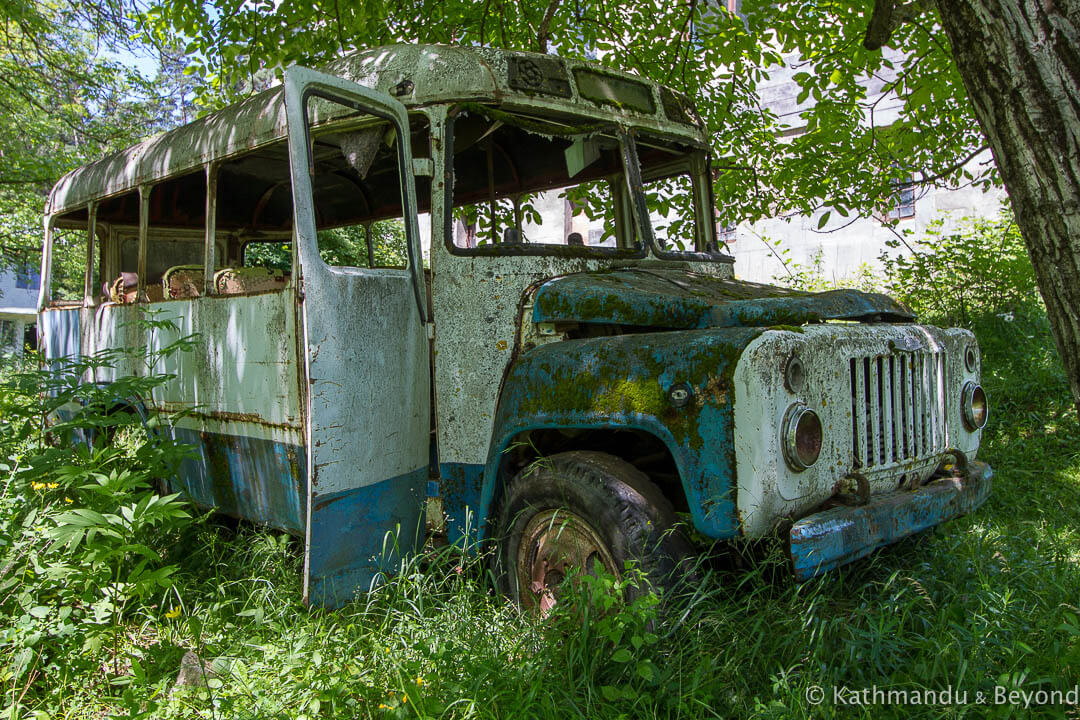
READ MORE OF OUR POSTS FEATURING ABANDONED PLACES
READ MORE OF OUR POSTS FEATURING THE CAUCASUS REGION
WHY NOT PIN THIS POST TO YOUR TRAVEL OR ABANDONED PLACES BOARDS…
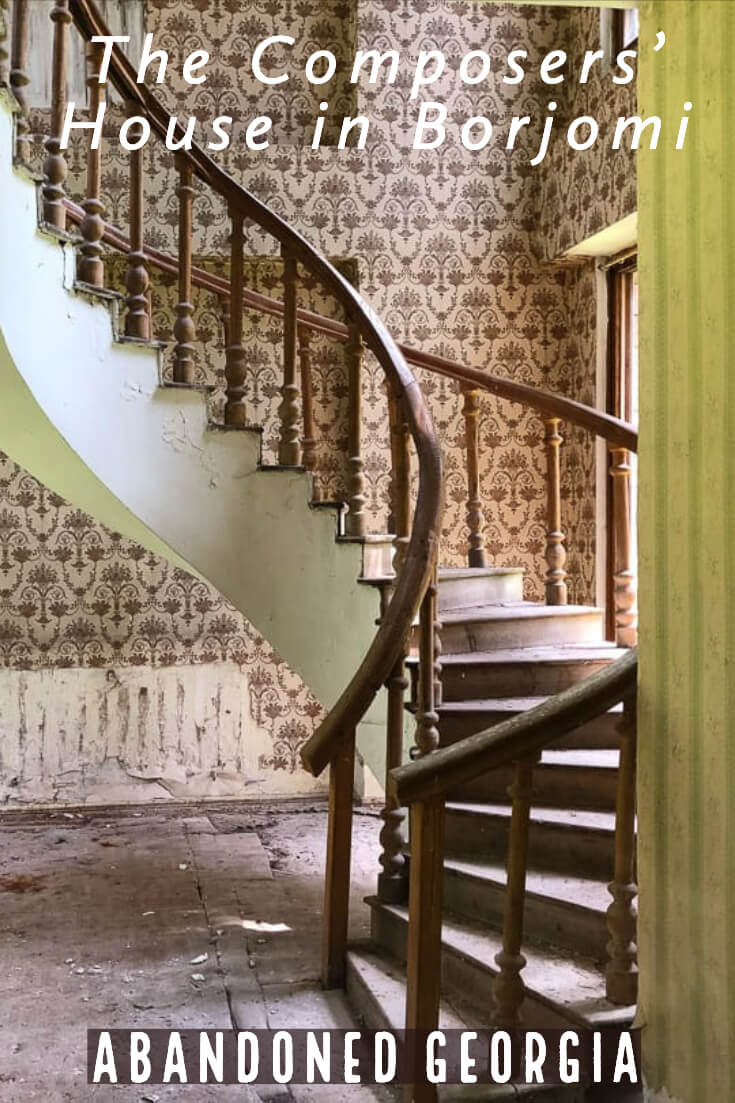
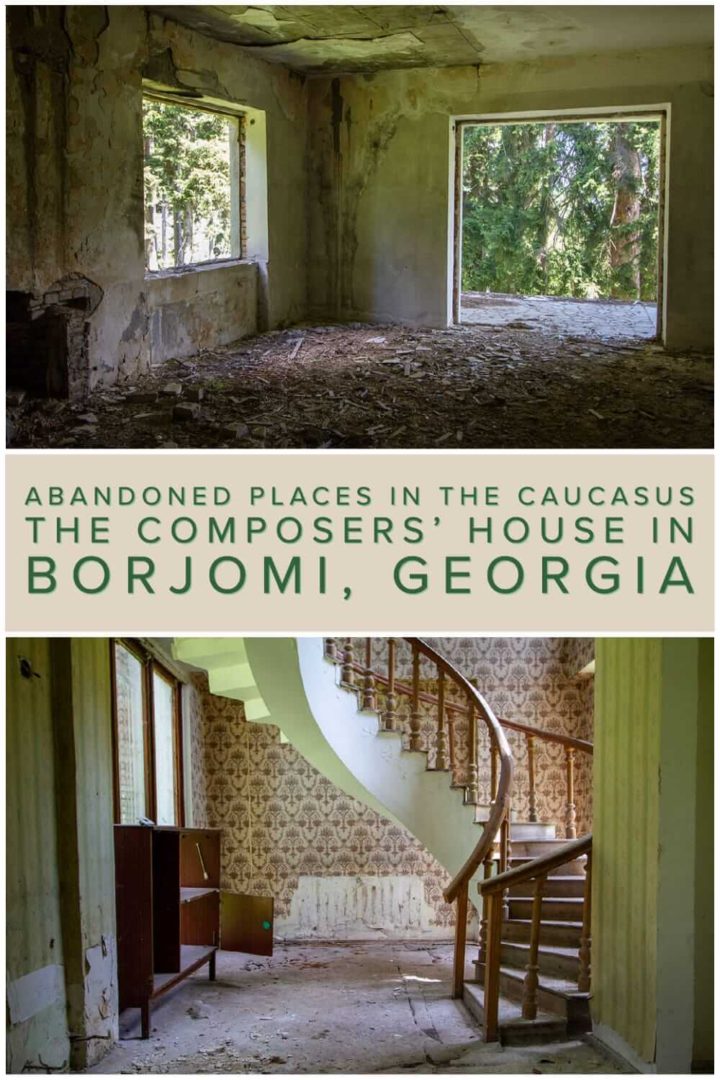
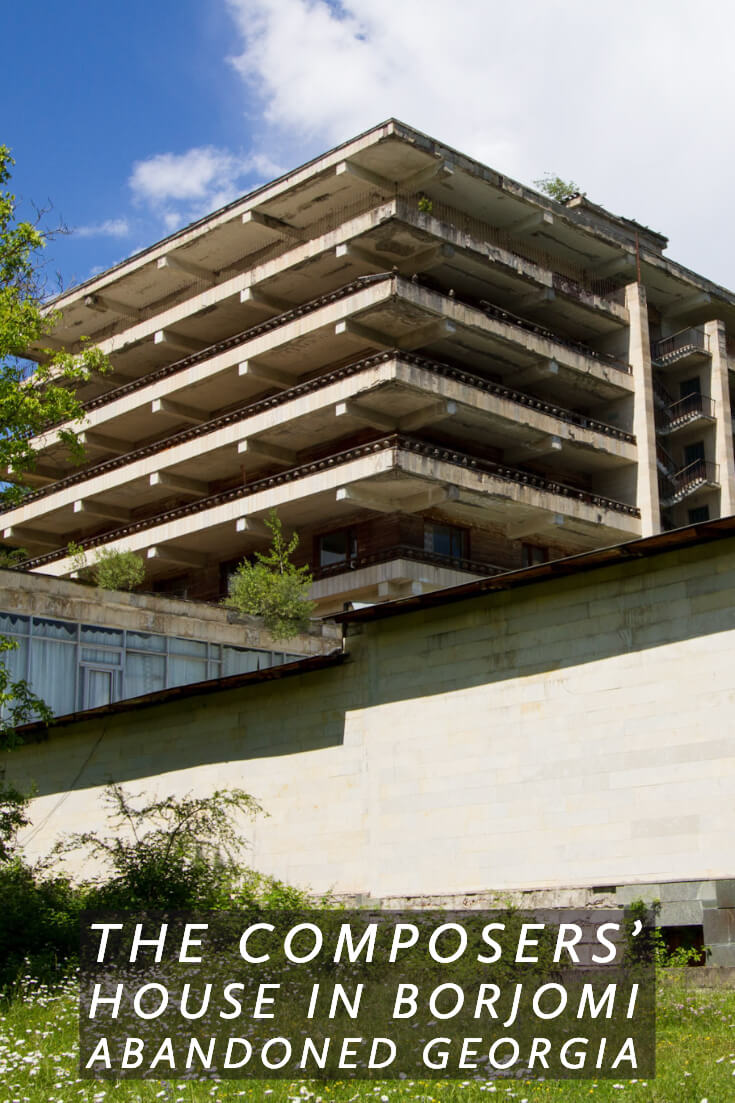

Hi, congratulations for the blogg!!! I would like to know where is it in Google maps. I’ve been looking but it was so hard, I didn’t find it and feel so frutrated.
Thanks, Almu. We sent you an email 😉
I would like to find it too, please!
Please share location! Here for two more days!
We have sent you an email
Nice story. Would love to get the location too pls
Hello! I’m wondering if I could please also know the location in Google maps as I plan to visit in April. TIA for this and for such incredible writing and research on Georgia!
Hi Kirsty, well done on finding it! We’ve also been searching for some time. Would you be happy to share the coordinates with us?
Thanks
Hello Laurie, we have sent you an email.
Hi, we‘re also looking for the house. Would you share the location?
Thank you 🙂
Hello Miriam, we have sent you an email.
Hey guys, I was up on the hill opposite the Crowne Plaza Hotel today and there was a very large complex of buildings up here. However before I had the chance to explore the whole complex the light began to fade and then a very scary sounding dog started barking loudly nearby and sounded like it was coming for me, so I ran out of there heading east to the main road and then walked back into town (1 mile) in the rain. Would you mind sharing the Google Maps coordinates of the building?
Hi Kirsty,
we are for a couple of days in Borjomi, it would be very kind of you to share the location. Thank you
Hello Erika, we have sent you an email.
Hi! I’m planning to go there in July, can you please share the precise location? Thank you so much!
Hi, would you be so kind to share the location ?
Hi, can you please send me the location? Thanks
Hi, can I ask you for the location of the composers house ? Thanks a lot !
I’ve been trying to find the location of this place but have had no luck. Could you send me the location by chance?
A small update on the location. There were rumours on works going on but I didn’t see anything when I went there last August. There’s a security post at the main entrance but it’s very easy to get there from the other side. The place is not in great shape inside but still worth visiting to my opinion.
Thanks for the update. It sounds like not much has changed since our visit in 2019. However, we didn’t manage to get in then, as there were workmen inside. I guess money for the renovation is scarce/drying up so it is going to take a while before anything major happens.
Hello – Any chance we could also be sent the location?
Hey, could you send us the location, too? We would really like to give you all an update on it’s current state 🙂